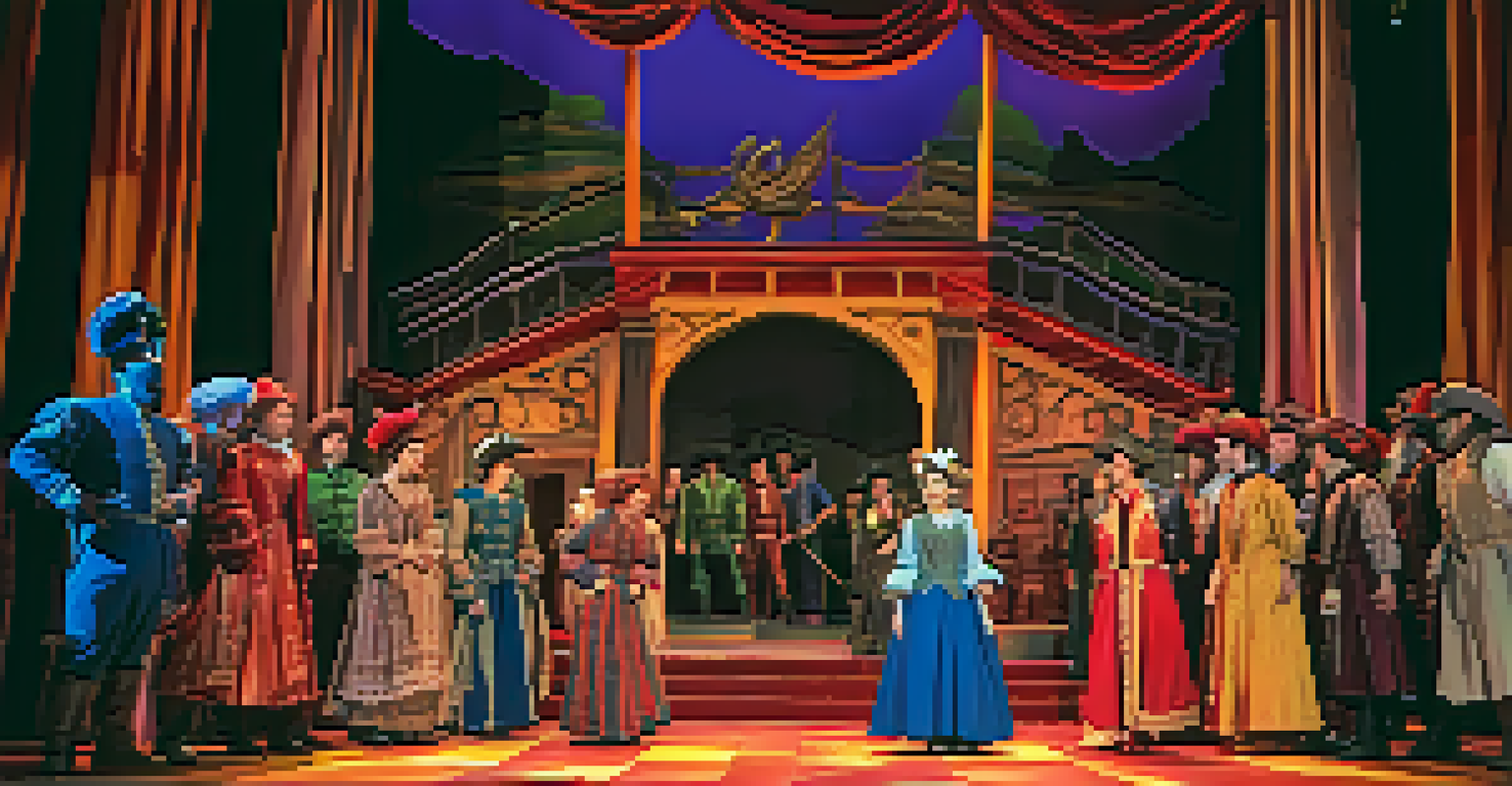Famous Adaptations: What Makes Them Stand the Test of Time?

The Allure of Classic Literature in Film Adaptations
Classic literature often serves as the backbone of many beloved films. Stories like 'Pride and Prejudice' and 'The Great Gatsby' have been reimagined through various cinematic lenses, bringing timeless narratives to new audiences. These adaptations maintain the essence of the original texts while making them accessible to those who may not pick up a book.
The beauty of literature is that it can be transformed, reimagined, and reinterpreted without losing its essence.
What makes these adaptations resonate is their ability to capture the emotional core of the original story. For instance, the 2005 film adaptation of 'Pride and Prejudice' beautifully conveys the tension and romance between Elizabeth Bennet and Mr. Darcy, allowing viewers to experience the same feelings that readers have cherished for generations.
Moreover, these adaptations often incorporate modern filmmaking techniques, such as stunning visuals and compelling performances. This blend of classic storytelling with contemporary artistry creates a rich tapestry that appeals to both old fans and new viewers alike.
Transformative Power of Stage Plays into Film
Stage plays hold a unique charm, and when adapted into films, they often bring a fresh perspective. Productions like 'Hamilton' and 'Les Misérables' have found immense success in transitioning from stage to screen, showcasing the captivating energy of live performances in a cinematic format. This transformation allows for a wider reach, introducing the magic of theater to countless new fans.

One contributing factor to their enduring appeal is the emotional depth portrayed by actors in both mediums. For instance, the raw passion of the performers in the film adaptation of 'Les Misérables' resonates deeply, making the audience feel every note of its poignant score. The combination of music, drama, and visual storytelling creates a powerful experience.
Classic Literature Inspires Films
Classic literature adaptations successfully bring timeless stories to new audiences while maintaining their emotional essence.
Additionally, film adaptations of stage plays often utilize unique cinematography to enhance the storytelling. Techniques such as close-ups and dynamic camera angles can elevate the emotional stakes, drawing audiences into the characters' world in a way that a theater seat cannot.
The Impact of Graphic Novels on Film Adaptations
Graphic novels have emerged as a significant source for film adaptations, bridging visual art with storytelling. Titles like 'Watchmen' and 'Persepolis' have captivated audiences with their unique narratives and artistic styles. The vivid illustrations in graphic novels translate well to the screen, creating visually dynamic films that hold true to their source material.
Adaptation is about translation, not transcription; it’s about finding a new way to express the same ideas.
What sets these adaptations apart is their ability to convey complex themes through a blend of visuals and dialogue. For example, 'Persepolis' tells a powerful personal story set against a backdrop of political upheaval, marrying art with history in a way that resonates with viewers. This duality creates a rich narrative experience that remains impactful.
Furthermore, the cultural significance of graphic novels often brings deeper layers to their film adaptations. By exploring themes of identity, struggle, and resilience, these films not only entertain but also provoke thought, ensuring they stand the test of time.
Why Animated Adaptations Remain Timeless Classics
Animated adaptations have carved a niche in the hearts of both children and adults. Disney's reimagining of fairy tales, such as 'The Lion King' and 'Beauty and the Beast,' showcases how animation can breathe new life into classic stories. These films often combine nostalgia with modern storytelling, appealing to multiple generations.
The artistry involved in animation allows for boundless creativity, bringing fantastical elements to life in ways live-action cannot. The vibrant colors, imaginative character designs, and enchanting soundtracks create an immersive experience that draws viewers into the narrative. This visual magic is a key factor in their lasting appeal.
Stage Plays Transform into Cinema
Adapting stage plays into films introduces captivating energy and emotional depth, broadening their reach and appeal.
Moreover, animated adaptations often address universal themes such as love, bravery, and friendship. These relatable messages resonate across age groups, making them timeless tales that continue to be cherished long after their initial release.
Video Game Adaptations: Bridging Two Dynamic Worlds
Video game adaptations have gained popularity in recent years, as franchises like 'The Witcher' and 'Mortal Kombat' transition to film and series formats. These adaptations tap into an existing fanbase while introducing new viewers to exciting narratives. The challenge lies in capturing the essence of the game while crafting a compelling story for the screen.
Successful adaptations often retain key elements that fans love, such as iconic characters and thrilling action sequences. For example, 'The Witcher' series has garnered praise for its faithful representation of the source material, balancing character development with epic battles. This attention to detail ensures that the adaptation resonates with gamers and non-gamers alike.
Additionally, the interactive nature of video games allows for rich storytelling experiences. When adapted thoughtfully, these stories can explore complex characters and intricate plots, making them suitable for cinematic storytelling. This merging of mediums can create adaptations that stand out in a crowded entertainment landscape.
The Role of Cultural Context in Adaptations
Cultural context plays a vital role in the success of adaptations, influencing how stories are interpreted and portrayed. For instance, adaptations of Shakespeare's works often reflect contemporary societal issues, making them relevant to modern audiences. This adaptability allows classic tales to resonate across generations and cultures.
Consider the film 'Romeo + Juliet' directed by Baz Luhrmann, which sets the iconic love story in a modern setting while retaining the original dialogue. This creative approach highlights the timelessness of the themes of love and conflict, making Shakespeare accessible to a new audience. Such reinterpretations breathe new life into the material.
Cultural Context Enhances Adaptations
Cultural context influences how stories are interpreted, making adaptations more relevant and enriching for modern audiences.
Moreover, adaptations that embrace cultural diversity often create richer narratives. By incorporating different cultural perspectives, filmmakers can offer fresh insights into familiar stories, enhancing their relevance and appeal. This inclusivity not only enriches the adaptation but also fosters greater connection with diverse audiences.
The Enduring Legacy of Iconic Adaptations
Iconic adaptations often leave a lasting legacy that influences future creators. Films like 'The Godfather' and 'The Shawshank Redemption' have set high standards for storytelling, character development, and cinematic artistry. Their impact extends beyond entertainment, inspiring filmmakers, writers, and artists across various disciplines.
These adaptations achieve timelessness by evoking strong emotional responses. The powerful performances and unforgettable quotes from these films continue to resonate, ensuring they remain a part of popular culture. Their ability to connect with audiences on a profound level solidifies their status as classics.

Additionally, iconic adaptations often spark discussions about their source material, leading to renewed interest in the original works. This cycle of inspiration and exploration allows classic stories to thrive in new formats, ensuring they remain relevant and cherished through the ages.